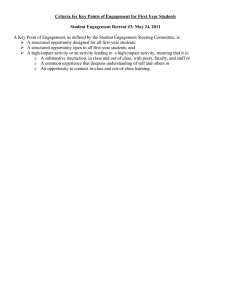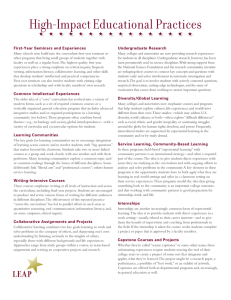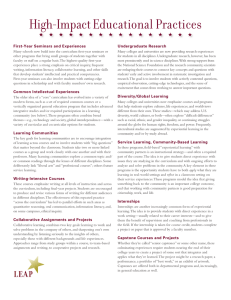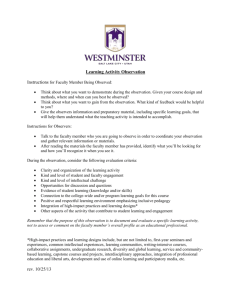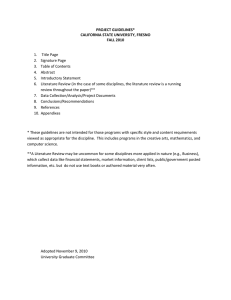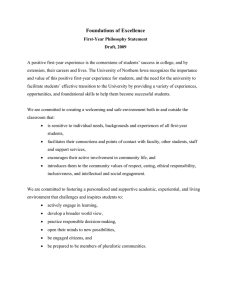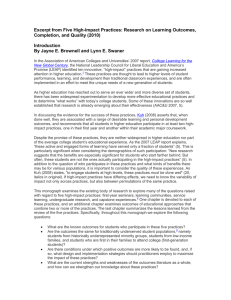High-Impact Practices Educational •
advertisement
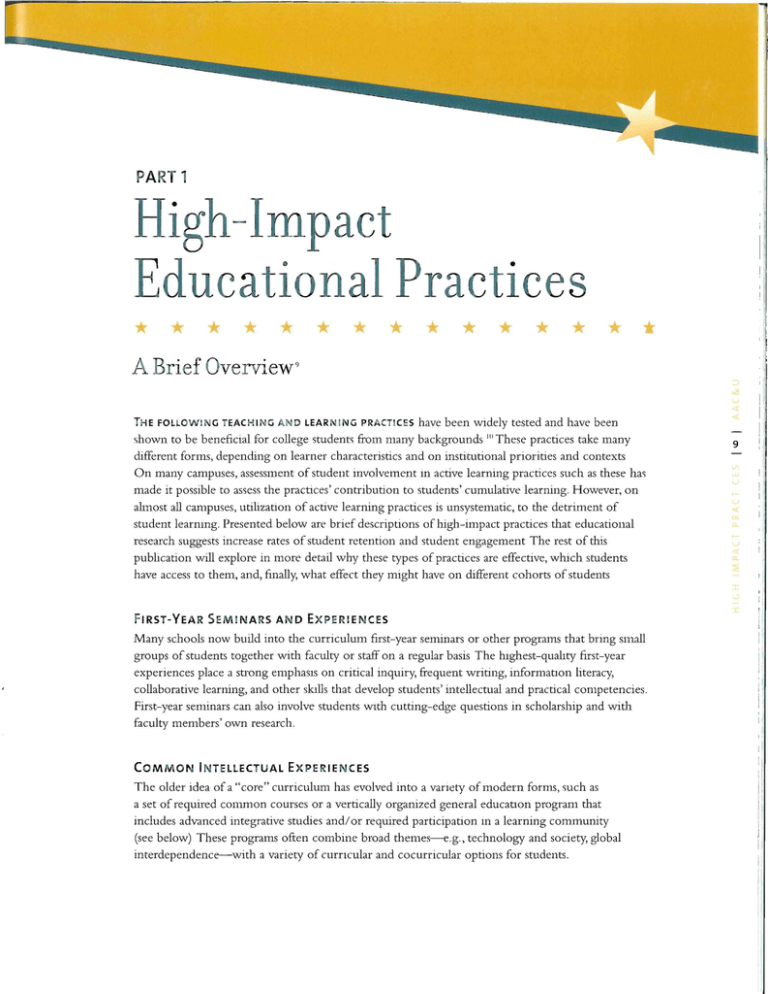
., PART 1 High-Impact Educational Practices * * * * * * * * * * * * * * A Brief Overview • 9 have been widely tested and have been shown to be beneflCial for college students from many backgrounds Iii These practices take many different forms, depending on learner characteristics and on institutional priorities and contexts On many campuses, assessment of student involvement in active learning practices such as these has made it possible to assess the practices' contribution to students' cumulative learning. However, on ahnost all campuses, utilization of active learning practices is unsystematic, to the detriment of student learmng. Presented below are brief descriptions of high-impact practices that educational research suggests increase rates of student retention and student engagement The rest of this publication will explore in more detail why these types of practices are effective, which students have access to them, and, fmally, what effect they might have on different cohorts of students THE FOLLOWI N G TEAC H I N G AN D LEAR N I NG PRAC TI CES F IRST-YEAR SEM I NARS A N D EXPERIE N CES Many schools now build into the curriculum first-year seminars or other programs that bring smail groups of students together with faculty or staff on a regular basis The highest-quality first-year experiences place a strong emphasIs on critical inquiry, frequent writing, informatlOn literacy, collaborative learning, and other skllls that develop students' intellectual and practical competencies. First-year seminars can also involve students WIth cutting-edge questions in scholarship and with faculty members' own research. COMMON I N TELLECTUAL EXPERIE N CES The older idea of a "core" curriculum has evolved into a variety of modern forms, such as a set of required common courses or a vertically organized general educatlon program that includes advanced integrative studies and/ or required participation 111 a learning community (see below) These programs often combine broad themes-e.g., technology and society, global interdependence-with a variety of curncular and cocurricular options for students. 9 i !' I I I ~ LEA RN I N G CO M MUNI T IE S The key goals for learning communities are to encourage integration oflearning across courses and to involve students with "big questions" that matter beyon d the classroom. Students take two or more linked courses as a group and work closely with one another and w ith their professors. Many learning communities explore a common topic and/or common readings through the lenses of different disciplines Some deliberately link "liberal arts" and "professional courses", others feature service learning (see p. 11). W RITI N G-I NTEN SIVE C O URSE S These courses emphasize writing at all levels of instruction and across the curriculum, including final-year projects. Students are encouraged to produce and revise various forms of writing for different audIences in different disciplines. The effectiveness of this repeated practice " across the curnculum" has led to parallel efforts in such areas as quantitative reasoning, oral communication, information literacy, and, on some campuses, ethical inquiry. C OL LA BORAT IVE A SS I G NM EN TS A N D P ROJ ECTS Collaborative learning combines two key goals: learning to work and solve problems in the company of others, and sharpening one's own understanding by listening seriously to the insights of others, especially those with different backgrounds and life experiences Approaches range from study groups within a course, to team-based assignments and writing, to cooperative projects and research. UNDERGRA DU ATE R ESE A RCH Many colleges and universities are now proViding research experiences for students in all disciplines Undergraduate research, h owever, has been most prominently used in science disciplines With strong support trom the N ational Science Foundation and the research corrununity, scientists are reshaping their courses to connect key concepts and questions with students' early and active involvement in systematic investigation and research The goal is to involve students with actively contested questions, empirical observation, cutting-edge technologies, and the sense of excitement that comes from working to answer important questions DI V ERSITV/ G LO BAL LEARNIN G Many colleges and universities now emphasize courses and programs that help students explore cultures, life experiences, and worldvlews different from their own. These studies-which may address U.S diversity, world cultures, or both-often explore "difficult differences" such as racial, ethmc, and gender inequality, or continuing struggles around the globe for human rights, fi.-eedom, and power Frequently, intercultural studies are augmented by experiennallearning in the community and/ or by study abroad. SERVI E N G , U ITY~ ED In these programs, field-based" experiential learning" with community partners is an instructional strategy-and often a required part of the course The idea is to give students direct experience with issues they are studying in the curnculum and with ongoing efforts to analyze and solve problems in the community A key element in these programs is the opportunity students have to both apply what they are learning in real-world settings and rlj1ect in a classroom setting on their serVICe expenences These programs model the Idea that giving something back to the commumty is an important college outcome, and that working with community partners is good preparation for citizenship, work, and life INTERNSHIPS Internships are another increasingly corrullon form of expenentiallearning. The idea is to provide students with direct experience in a work settmg-usually related to their career interests-and to give them the benefit of supervision and coaching from professionals in the field. If the internship is taken for course credit, students complete a project or paper that is approved by a faculty member E RSES ECTS Whether they're called "senior capstones" or some other name, these culminating expenences require students nearing the end of their college years to create a project of some sort that integrates and applies what they've learned The project rrught be a research paper, a performance, a portfolio of "best work," or an exhibit of artwork. Capstones are offered both m departmental programs and, increasingly, in general education as well. Source: High-Impact Educational Practices: What They Are, Who Has Access to Them, and Why They Matter, by George D. Kuh (AAC&U, 2008) 11
